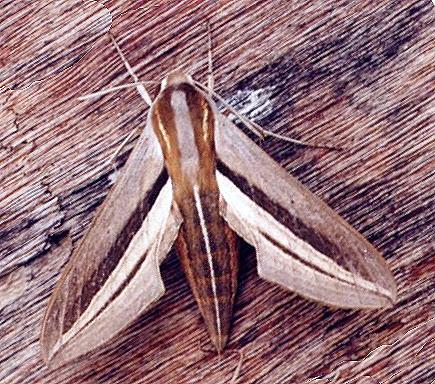
| (previously known as Chaerocampa margarita) MACROGLOSSINAE, SPHINGIDAE, BOMBYCOIDEA | (donherbisonevans@yahoo.com) and Stella Crossley |

(Photo: courtesy of Tom and David Sleep, Brisbane, Queensland)

| (previously known as Chaerocampa margarita) MACROGLOSSINAE, SPHINGIDAE, BOMBYCOIDEA | (donherbisonevans@yahoo.com) and Stella Crossley |

(Photo: courtesy of Tom and David Sleep, Brisbane, Queensland)
The first instar Caterpillars of this species are green with a yellowish head and a short black spike on the tail. The second instars may be either green or brown with a row of dark spots along each side of the back. In the third and fourth instars the tail spike becomes shorter with a red base and the rows of dark spots become eyespots.
The caterpillars feed on plants in NYCTAGINACEAE such as
The last instar can become various shades of brown sometimes with patchy or diagonal patterns, the seven equal eyespots each side become larger, and the tail spike becomes very short and brown. The anal plate from the base of the spine to the claspers becomes nearly vertical.
The caterpillars grow to a length of about 6 cms. They walk away from the foodplant to pupate in a loose cocoon amongst the ground litter. The pupa is speckly brown and tubby, with a dark spot on the side of each segment. The length of the pupa is just over 3 cms.

The adult moths have light brown forewings each with a pair of stripes, one dark brown and one white, running from base to wingtip. The moths have plain brown hindwings, and have a wingspan of about 6 cms.
The eggs are oval and yellow, with a length of about 1.5 mms. The eggs are laid singly on the upper surfaces of foodplant leaves.
The species has been found in :
Further reading :
William Forsell Kirby,
Notes on the new or rare Sphingidae in the Museum of the
Royal Dublin Society,
Transactions of the Entomological Society of London,
1877, Part 3, pp. 235, 240-241.
Maxwell S. Moulds, James P. Tuttle and David A. Lane.
Hawkmoths of Australia,
Monographs on Australian Lepidoptera Series, Volume 13 (2020),
pp. 251-257, Plates 65, 81, 91.
Buck Richardson,
Tropical Queensland Wildlife from Dusk to Dawn Science and Art,
LeapFrogOz, Kuranda, 2015, p. 203.
 caterpillar |  butterflies |  Lepidoptera |  moths |  caterpillar |
(updated 27 June 2009, 1 April 2014, 7 March 2015, 13 December 2020 )